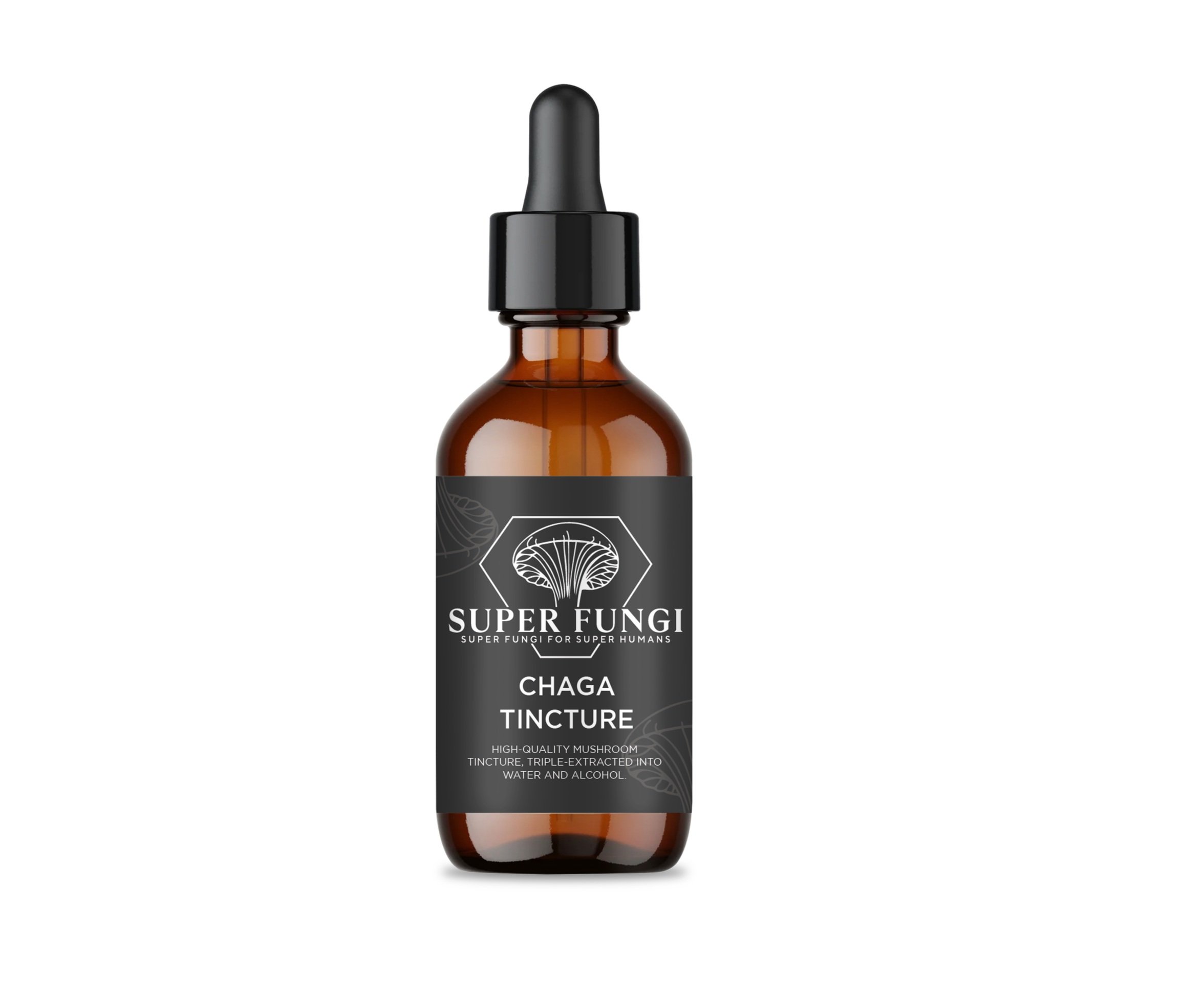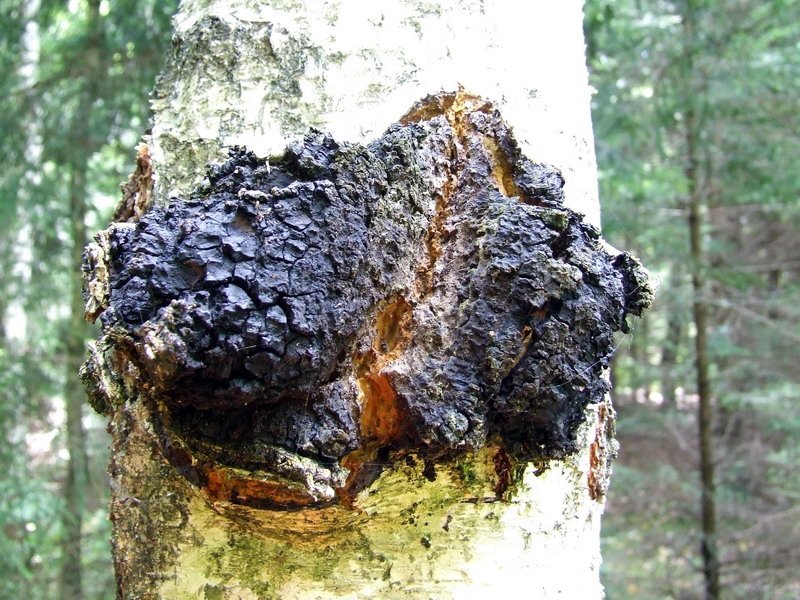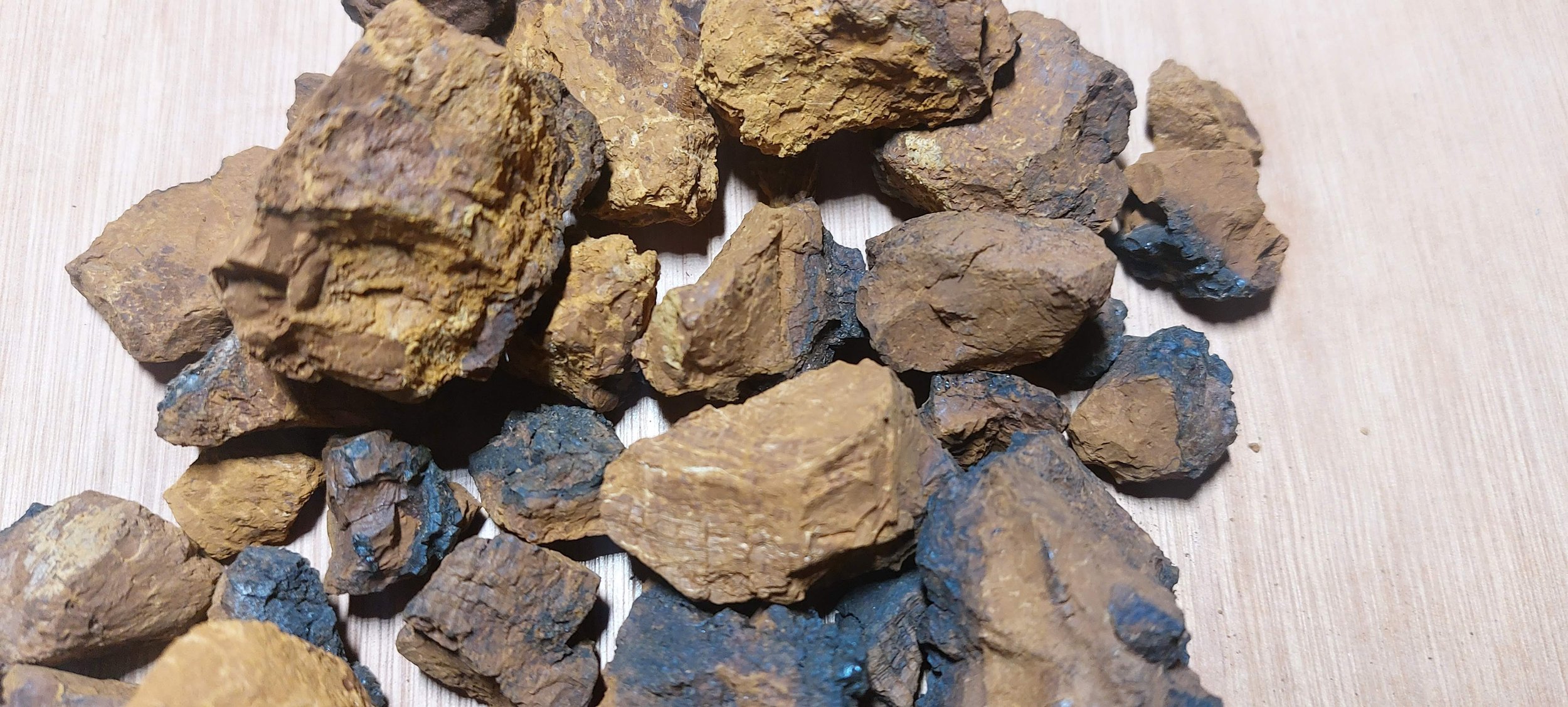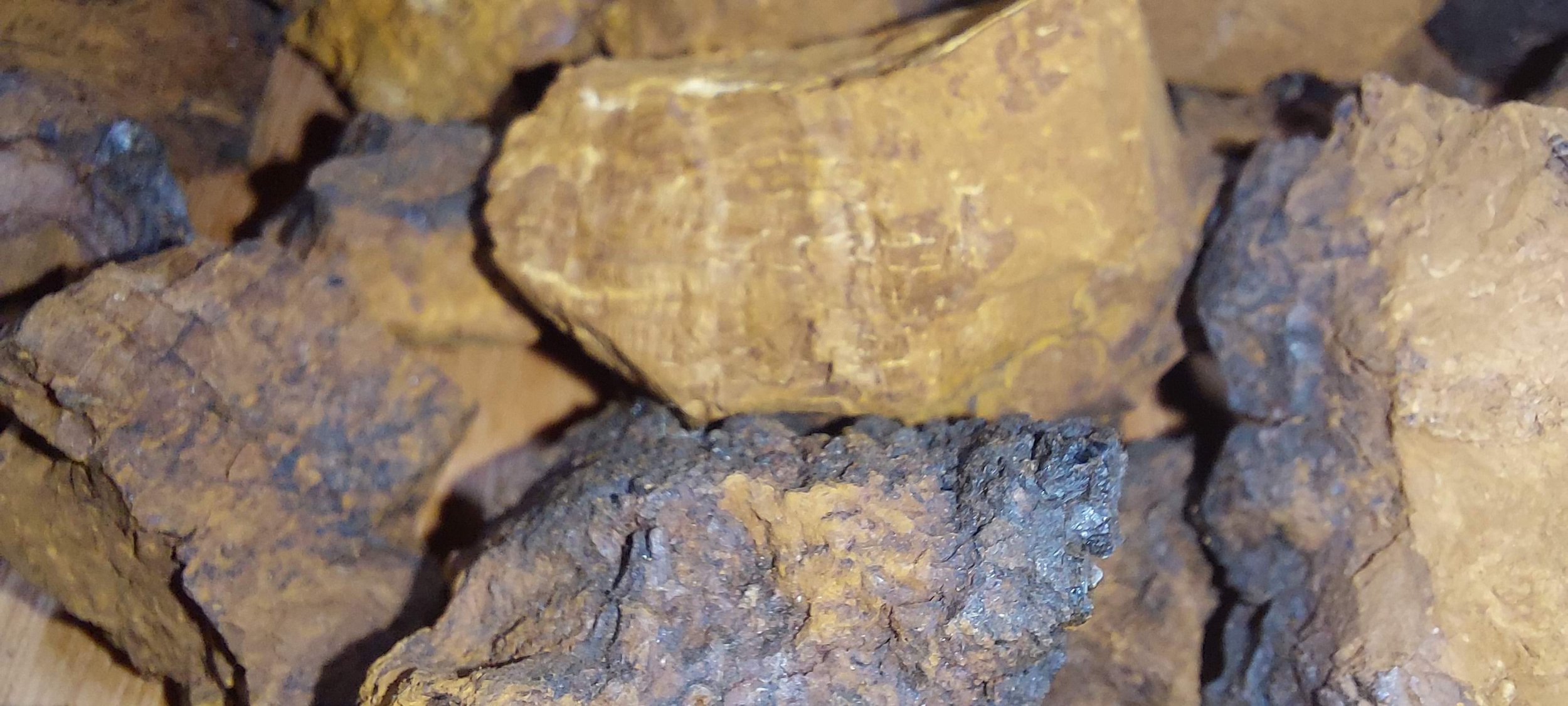 Image 1 of 5
Image 1 of 5

 Image 2 of 5
Image 2 of 5

 Image 3 of 5
Image 3 of 5

 Image 4 of 5
Image 4 of 5

 Image 5 of 5
Image 5 of 5






1:4 Chaga Tincture. Triple Extracted Good Stuff. For: Adaptation. Defence. De-Stress.
Chaga – Inonotus obliquus.
Welsh-made, 1:4 ratio Chaga tincture, extracted and made by us at our lab in the heart of Bannau Brycheiniog
Grown and foraged sustainably on a Hebridean Island in Scotland.
100% dried Inonotus obliquus sclerotium (Chaga is a growth rather than a fruiting body)
Triple-extracted at 1:4 ratio
No additives, fillers, chemicals or funny business.
Fully transparent, traceable supply chain. We grow and forage all of our mushrooms ourselves, so you know exactly where your product has come from, from spore to store.
Bottle size: 50ml. This should last around a month.
Ingredients: Inonotus obliquus sclerotium, spring water, organic grain alcohol
What’s it good for?
Chaga, or the compounds extracted from it, has been through a few human clinical trials. These studies have shown potential impacts on:
lowering blood sugar (Ying et al, 2014)
reducing cholesterol (Gao et al, 2020)
reducing some inflammations (Fedotov and Yu, 1981)
psoriasis (Dodychev & Bystrova, 1973)
Gut conditions, potentially including Crohn’s disease (Najafzadeh et al, 2007)
defending against infection by promoting the formation of beneficial cytokines - proteins that help regulate our immune system - which stimulate white blood cells (Bulatov et al, 1959)
slowing tumour growth, probably via the effects of antioxidants on preventing cell damage by free oxygen radicals (Piaskowski, 1957)
Always consult your doctor/physician if you are expecting a child or breastfeeding a baby. If you are undergoing allopathic (medical) treatment for cancer, you might want to discuss your use of supplements to ensure that no contraindications are likely. Keep in mind that if you are a diabetic, Chaga’s potential impacts on blood sugar levels mean that you should not take Chaga products without prior consultation with a medical professional. Likewise, because Chaga contains a protein that can prevent blood clotting, potential side effects for those with bleeding disorders or who are due to undergo surgery or childbirth, mean that again, you should consult a medical professional first.
What is it?
Chaga is a common folk name for a fungi that has many different names around the world, including Clinker Polypore and Birch Canker. Here in the UK, it is officially known as a sterile conk trunk rot of birch. But Chaga, taken from the Russian for this mushroom - çaga - which in it’s turn is taken from the indigenous language of the Kama River Basin in Russia, is now well known.
In any event, this is a fungi that grows parasitically on birch trees. In the UK, Chaga is most abundant in latitudes in Scotland where Silver Birch is common. It is not always sustainably harvested, as cutting the ‘conk’ from the tree incorrectly can introduce more rapid disease into the host tree, causing premature death.
My Chaga was collected by a dear friend on a Scottish island, in very small quantities. It was done sustainably without harm to the trees or their surrounding environment. Photos of the tree before and after collection were taken along with a GPS pin of each tree, so that the site can be checked annually for any problems arising. I feel very certain that my product is not harming any part of our natural environment during collection.
How is our tincture made?
The tincture process for my Chaga tincture is as follows:
dehydrate the fresh sclerotia at low temperature for 48 hours until absolutely crisp.
Powedred and added to organic grain alcohol for 6 weeks, agitating daily.
Remove all solids from the alcohol and dehydrate
Add to spring water and simmer at just under boiling point for at least 6 hours.
Set the water extraction to one side
The remaining material is then extracted in warm-water ultrasound baths
The water and alcohol extractions are then combined to provide a 1:4 ratio of the fruiting bodies to liquid, with 20% alcohol content for shelf-life.
The final part of the process uses ultrasonic mixing to homogenise the tincture, which ensures every drop has the same potency as the last.
It’s then bottled, labelled and sent on it’s journey to your good self.
Taking the tincture
The bottle has a dropper with marks indicated on it. A full dropper per day is a recommended adult dose.
I tend to take mine in the morning to be sure it is part of my routine. The tincture is concentrated mushrooms and thanks to the tannins contained in Chaga, is bitter to taste. Not everyone likes the taste. Personally, I tend to add mine to my coffee or juice, again, as a part of my morning routine. You will notice some alcohol taste, which is the 20% organic grain ethanol I use to extract and preserve the shelf-life of my tinctures.
Your 50ml bottle should last between a month and six weeks. I have suggested a month’s break after the first 3 months: this is simply a precaution to help be sure that your body reacts well to the product, but it is not necessary if you are feeling benefits.
Thank you for buying my products. It means the world to me.
I simply collect or grow it, turn it into a tincture, package it and deliver it to you. No funny business. 100% grown, extracted and packaged in Bannau Brecheiniog, Wales, United Kingdom.
Chaga – Inonotus obliquus.
Welsh-made, 1:4 ratio Chaga tincture, extracted and made by us at our lab in the heart of Bannau Brycheiniog
Grown and foraged sustainably on a Hebridean Island in Scotland.
100% dried Inonotus obliquus sclerotium (Chaga is a growth rather than a fruiting body)
Triple-extracted at 1:4 ratio
No additives, fillers, chemicals or funny business.
Fully transparent, traceable supply chain. We grow and forage all of our mushrooms ourselves, so you know exactly where your product has come from, from spore to store.
Bottle size: 50ml. This should last around a month.
Ingredients: Inonotus obliquus sclerotium, spring water, organic grain alcohol
What’s it good for?
Chaga, or the compounds extracted from it, has been through a few human clinical trials. These studies have shown potential impacts on:
lowering blood sugar (Ying et al, 2014)
reducing cholesterol (Gao et al, 2020)
reducing some inflammations (Fedotov and Yu, 1981)
psoriasis (Dodychev & Bystrova, 1973)
Gut conditions, potentially including Crohn’s disease (Najafzadeh et al, 2007)
defending against infection by promoting the formation of beneficial cytokines - proteins that help regulate our immune system - which stimulate white blood cells (Bulatov et al, 1959)
slowing tumour growth, probably via the effects of antioxidants on preventing cell damage by free oxygen radicals (Piaskowski, 1957)
Always consult your doctor/physician if you are expecting a child or breastfeeding a baby. If you are undergoing allopathic (medical) treatment for cancer, you might want to discuss your use of supplements to ensure that no contraindications are likely. Keep in mind that if you are a diabetic, Chaga’s potential impacts on blood sugar levels mean that you should not take Chaga products without prior consultation with a medical professional. Likewise, because Chaga contains a protein that can prevent blood clotting, potential side effects for those with bleeding disorders or who are due to undergo surgery or childbirth, mean that again, you should consult a medical professional first.
What is it?
Chaga is a common folk name for a fungi that has many different names around the world, including Clinker Polypore and Birch Canker. Here in the UK, it is officially known as a sterile conk trunk rot of birch. But Chaga, taken from the Russian for this mushroom - çaga - which in it’s turn is taken from the indigenous language of the Kama River Basin in Russia, is now well known.
In any event, this is a fungi that grows parasitically on birch trees. In the UK, Chaga is most abundant in latitudes in Scotland where Silver Birch is common. It is not always sustainably harvested, as cutting the ‘conk’ from the tree incorrectly can introduce more rapid disease into the host tree, causing premature death.
My Chaga was collected by a dear friend on a Scottish island, in very small quantities. It was done sustainably without harm to the trees or their surrounding environment. Photos of the tree before and after collection were taken along with a GPS pin of each tree, so that the site can be checked annually for any problems arising. I feel very certain that my product is not harming any part of our natural environment during collection.
How is our tincture made?
The tincture process for my Chaga tincture is as follows:
dehydrate the fresh sclerotia at low temperature for 48 hours until absolutely crisp.
Powedred and added to organic grain alcohol for 6 weeks, agitating daily.
Remove all solids from the alcohol and dehydrate
Add to spring water and simmer at just under boiling point for at least 6 hours.
Set the water extraction to one side
The remaining material is then extracted in warm-water ultrasound baths
The water and alcohol extractions are then combined to provide a 1:4 ratio of the fruiting bodies to liquid, with 20% alcohol content for shelf-life.
The final part of the process uses ultrasonic mixing to homogenise the tincture, which ensures every drop has the same potency as the last.
It’s then bottled, labelled and sent on it’s journey to your good self.
Taking the tincture
The bottle has a dropper with marks indicated on it. A full dropper per day is a recommended adult dose.
I tend to take mine in the morning to be sure it is part of my routine. The tincture is concentrated mushrooms and thanks to the tannins contained in Chaga, is bitter to taste. Not everyone likes the taste. Personally, I tend to add mine to my coffee or juice, again, as a part of my morning routine. You will notice some alcohol taste, which is the 20% organic grain ethanol I use to extract and preserve the shelf-life of my tinctures.
Your 50ml bottle should last between a month and six weeks. I have suggested a month’s break after the first 3 months: this is simply a precaution to help be sure that your body reacts well to the product, but it is not necessary if you are feeling benefits.
Thank you for buying my products. It means the world to me.
I simply collect or grow it, turn it into a tincture, package it and deliver it to you. No funny business. 100% grown, extracted and packaged in Bannau Brecheiniog, Wales, United Kingdom.
Please Note - once my current stock of Chaga is sold, I will not be making further batches. This is in line with my decision to focus on Lion’s Mane - fresh and tincture - in the future. I’m sorry if this is bad news, but I need to focus my energy on the tinctures I can grow myself locally, rather than forage.
